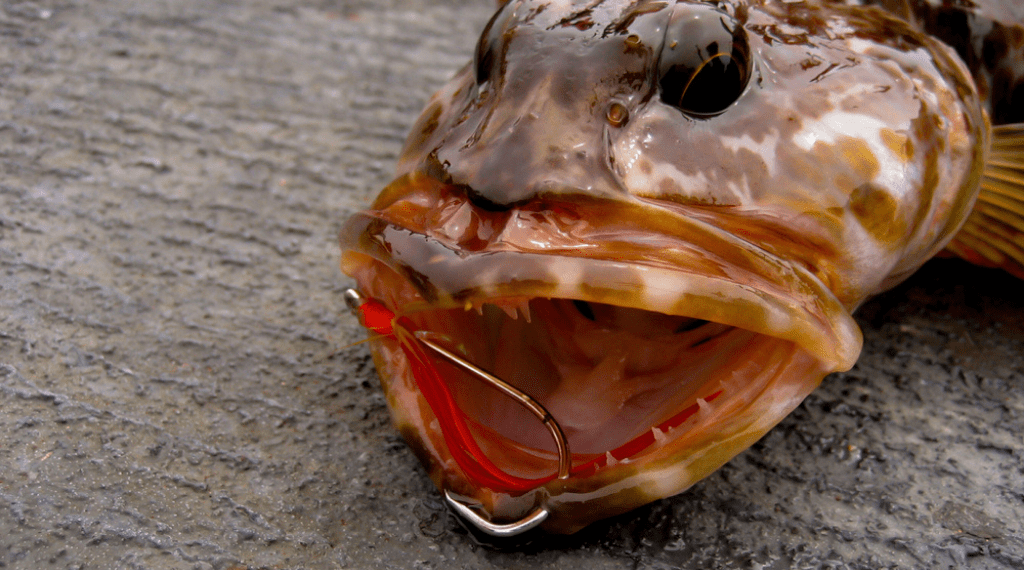Lingcod may not look pretty, but they sure are tasty. Their combative nature makes them a challenging and fun fish to catch.
This article will discuss everything you need to know about how to catch lingcod.
You’ll find out where and when to catch lingcod, some lingcod tips and tricks, plus we’ll even share three great lingcod recipes you can try.
So keep reading to learn how to catch lingcod and more…..
Lingcod Basics
Lingcod fish are grotesque-looking, bottom-dwelling creatures that have quite the deceitful name. These unique creatures also have many other names they go by, including:
- Buffalo Cod
- Cultus Cod (or False Cod)
- Green Cod
- Ling Fish
- Buckethead Fish
Lingcod fish are actually part of the greenling family, which is different from a true cod. They have a relatively smooth body and a long dorsal fin. Its large mouth and protruding sharp teeth are reminiscent of a sea creature from childhood fables. This fish is a predator with 18 viciously sharp teeth and can live up to 25 years, making a terrific trophy for some lucky angler.
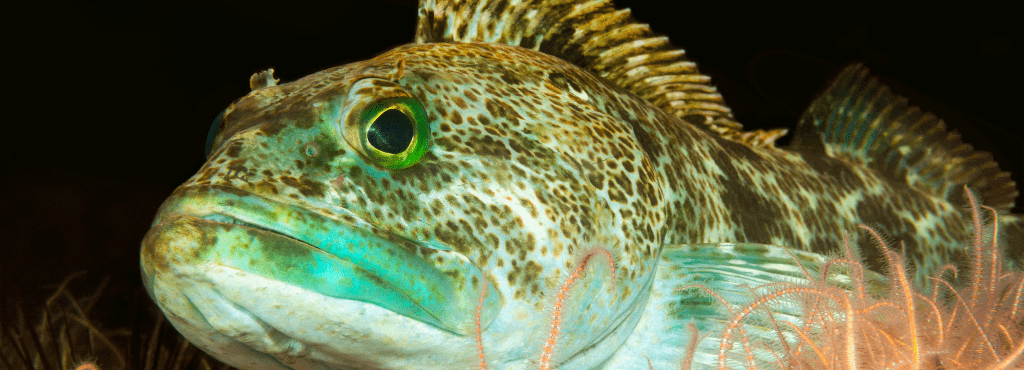
Consequently, the lingcod carries with it an attitude and disposition to match its aggressive appearance. They will gather in areas with rocky bottoms to feed, but to a lingcod, anything moving can be a meal. Their combative nature makes catching this fish a fun challenge for many anglers.
Most fish, including most lingcod, generally have white meat with a slight pink tint. Lingcod, however, is one of the few fish who have a diet that changes the color of their flesh from white to neon blue! Typically, you will find brown or grey varieties, where they may have colorful blotches of blue or orange lines throughout their body.
Female lingcod will generally be larger than the males. The largest lingcod that was ever captured was over 80 pounds (35 kg). With that amount of mass built into a body that can grow up to five feet (150 cm.), the lingcod isn’t a fish that just anyone can conquer. That is if they’re on the hunt for their next trophy catch.
Lingcod fishing, especially when going for the larger ones, can be a simple task for the average angler but takes research, preparation, and a lot of money. Unfortunately, gathering supplies and finances is up to you.
Luckily, though, the research has been done for you! Below, you’ll find an in-depth guide with everything it takes to find, catch and cook a delicious dish with your trophy catch! The only thing left up to fate is whether you find a turquoise lingcod!

How To Catch Lingcod
Lingcod habitats are only on the west coast of North America in the cold Pacific waters. Knowing where and how to catch lingcod will give you an advantage over anglers who don’t do their homework ahead of time.
The nightmare fish lives in caves and caverns on the ocean/estuary floor. A few, but not nearly all, of the places for lingcod fishing are:
- The Gulf of Alaska
- Oregon Coast
- Baja California, México
- The Outer Kenai Peninsula
- Kodiak
- The Prince William Sound
- Seattle, Washington
- Most any body of water that reaches a depth of 40 feet (12.1 m.) on the west coast
You can find lingcod fish at depths of almost 2,000 feet (609.6 m.), but they usually live closer to shore on the rocky floor of reefs. You can even catch them from shore, which is certainly a bonus for anglers without a boat!
If you do have a boat, though, you have a serious advantage when it comes to catching lingcod. Since the fish is a bottom-dweller that sticks to deep, dark caverns, the lingcod is not always an easy catch from shore. Of course, it is possible, but a boat certainly makes the task easier.
This fish prefers rocky areas, cliffs, and boulders as these spaces allow ample camouflage for them to wait for prey. Because lingcod fish do not have swim bladders, they cannot regulate their swimming depth, so it takes a lot of energy to swim around searching for food. Typically, they are lazy and prefer to lie on the bottom, waiting for unsuspecting prey to present themselves.
Best Time of Day for Lingcod Fishing
The great thing about lingcod fishing is that the lingcod are always hungry! As long as it’s daytime, the lingcod are ready to eat whatever gets thrown their way.
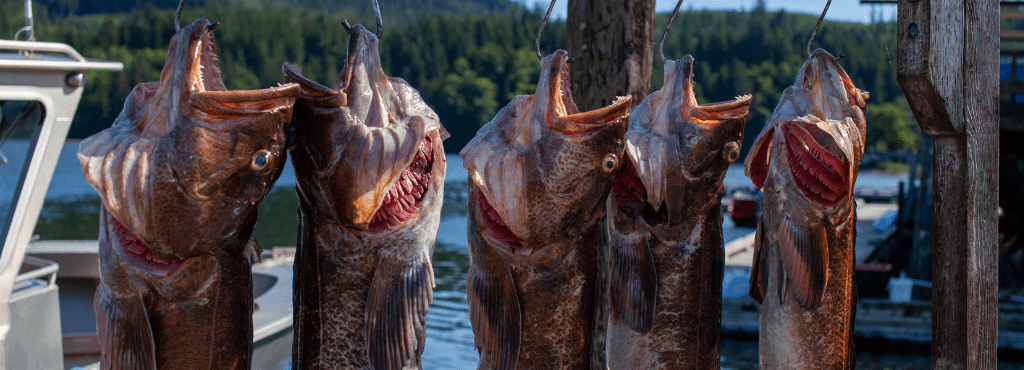
Some anglers say they have the most luck with these aggressive fish before noon, but that’s less of an issue for lingcod than other fish. More often than not, the weather conditions will determine the availability of this fish rather than the time of day.
Best Time of Year for Lingcod Fishing
Springtime is typically lingcod fishing season, or from December to May.
In order to spawn, the lingcod make their way toward shore and lay their eggs in the shallow water. This timing makes for the perfect chance for catching a lingcod. Since the lingcod will be calorie-exhausted and crowded, the chance of getting lucky grows much higher.
However, there may be restrictions in specific areas, depending on the conservation of this species. For example, recreational fishing for lingcod is closed during its spawning and nesting seasons in Alaska. So before grabbing your gear and heading out to the water, it’s best to check for any existing regulations.
Best Weather Conditions for Lingcod Fishing
The key to lingcod fishing is timing and patience. So when deciding what day to go on your hunt for the elusive blue meat, you’ll want to check the forecast – and, no, not the regular one on your phone that tells you when it’ll rain.
You’ll want to check the wave and wind maps. These maps are primarily to be used by surfers, but that doesn’t mean anyone can’t make use of them!
If targeting lingcod from the short the perfect weather conditions for lingcod fishing are when the wind is heading offshore. The wind will be helpful when launching your cast. Lingcod fish prefer deeper water, so the distance of your cast is vital to lingcod fishing.
Best Lingcod Rig
There are a few things that you can’t fish for lingcod without, like some bait that is big enough to attract a lingcod.
The hookset is one element anglers should consider when finding the best lingcod rig. You should opt for a more subtle hookset, mainly because of how these large-mouth fish grab the bait. As aggressive feeders, they typically take the entire bait in their mouth. If they feel any powerful movement from your hook at this time, they will promptly spit it out, leaving you without bait or a fish for your plate.
As a general rule, trying to hook a lingcod means you will want to fish to the bottom with bait and lures they cannot resist. You’ll need a good bottom fishing reel with plenty of drag resistance if you are targeting large offshore lingcod.
Best Bait to Catch Lingcod
Luckily, lingcod fish are aggressive predators, so you have a pretty wide range of choices in a bait style. Some of the best lures and bait for lingcod are:
- Metal Jigs
- Live Bait
- Lead-Head Jigs
- Swimbaits
- Flutter Jigs
- Pipe Jigs
- 2-Hook Chicken Rigs
- Most Large Baits
The perfect lingcod bait comes down to one main thing: size. There are many options to choose from when choosing your lingcod bait. It can be beneficial to use the most prominent bait option available. These baits attract large and small lingcod, alike, so it’s best to use as big of the bait as possible. Your luck might be better when using a smaller bait option, but you’re less likely to catch a big lingcod.
Using a large no live bait needed swimbait lure works well for catching large lingcod, especially from a boat. If fishing a swimbait from shore, doing so from a pier and casting away from the shoreline will be most beneficial.
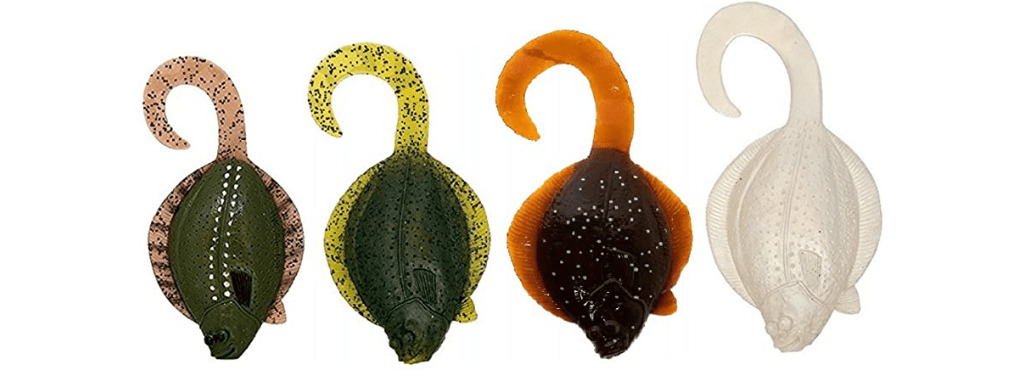
Proper casting will help you to get the best results with a swimbait. Your primary goal is to cast as far from yourself as possible. This method should allow for as much time as you can get to reel the swimbait in.
Live bait works well as lingcod bait but can be a nuisance and a waste of time to catch. Catching live bait can often lead to spending significant time you have to fish for your big catch by cutting it in half.
Live bait also tends to fall off the hook easier than lures since it will be squirming on the hook and fighting against you. There is also a significant chance that the bait may slide directly off or just break off the hook after a few bites from a lingcod fish.
Lingcod Jigging
Jigging is a technique that seasoned anglers often use to help catch fish that live along the bottom of a body of water. The quick, jerking motion that the angler applies while the line is in the water is characteristic of jigging. The rapid movement allows light to reflect from your lure/bait and ensures that it gets noticed by the lingcod.
There are many techniques for jigging, and everyone has a personal preference. However, there is a technique that can help with lingcod jigging. The idea is to use the free-jigging method, which employs the help of the oar holder on your boat.
Begin by placing your jigging rod into one of the oar holders. Next, cast your bait and get it to a depth that is just over the ocean floor or body of water. As you begin toward your waypoint, start by moving the rod up and down a few feet.
When moving over the waypoint, you continue this technique. Grabbing the fish’s attention can be tiring and frustrating when jigging, but it is an excellent method for catching the bottom-dwelling fish, like the lingcod.
Large metal jigs have a perfect reputation in the lingcod fishing community. Due to the wide variety in size and tie-on points, you can completely kit yourself with them to catch the biggest lingcod possible.
When deciding which color jig, it can be overwhelming. If you want to catch lingcod at 150-foot (45.7 m) depth or more, white or glow-in-the-dark will work best. Otherwise, orange or brown should do the trick! Ones that sink near the bottom or remain only an inch or two above the bottom will catch this fish’s eye, helping you capture your next lingcod fish.
Lingcod Spearfishing
Yes, you can go spearfishing for lingcod. But it’s not an easy task! Because of their lazy nature, they can be challenging to find among the rocks, caves, and crevices as they hide, waiting for their prey. You will need to go “hole hunting” which is as the name suggests looking into holes and caves to see if they hold any lingcod.
Although this may not be the preferred method to catch your lingcod, it provides an alternate way to experience the thrill of the catch. You will need a good diving flashlight and pole spear or spear gun to pierce them easily.
If you find jigging for lingcod becomes too easy for you, and don’t mind getting wet, try spearfishing the next time you head out for the day.
Lingcod Recipes: How to Cook Your Catch
Once you’ve finally got your lingcod, it’s time to prepare the feast! Lingcod makes for a delicious entree to celebrate your big catch. In addition, they are relatively cheap fish to purchase at a market if the day wasn’t ideal for lingcod fishing.
There are many great recipes for lingcod. Below are three delicious recipes to try after a fun day out on the water.
Pan Seared Lingcod
This pan-seared lingcod recipe is simple and easy, but don’t let that make you think it’s not delicious! Not many extra flavors are necessary with lingcod, so anyone who tries this seafood recipe should be satisfied and impressed with the harvest! This recipe pairs well with garlic mashed potatoes or another comfort food side.
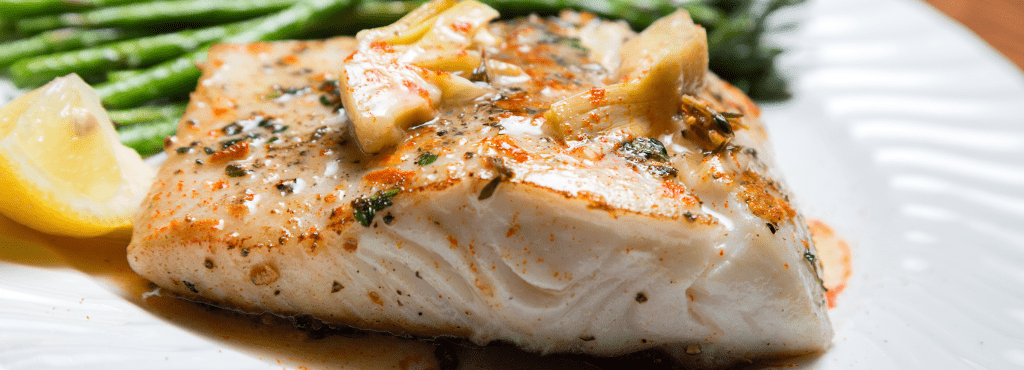
You’ll need:
- Lingcod filet(s)
- Cooking oil
- Lemon
- Capers
- Skillet or Pan
- Butter
Instructions:
- Pat your lingcod dry.
- Dust lingcod with flour (or a gluten-free alternative).
- Add oil and butter to a pan.
- Heat the pan to melt the butter.
- Add your favorite yummy herbs/spices! (Optional)
- Add the lingcod and cook each side for 3-4 minutes.
- Remove the lingcod.
- Add lemon juice and capers to the pan.
- Serve lingcod with pan sauce.
Panko Lingcod
This recipe is slightly more advanced than the last, but not by much. However, the extra few minutes you spend preparing this meal when the golden-brown breading and somewhat tangy flavor collide with the oven-baked lingcod. It tastes delectable and looks absolutely stunning in any setting. You and your guests will be amazed at how quickly you whipped up a masterpiece.
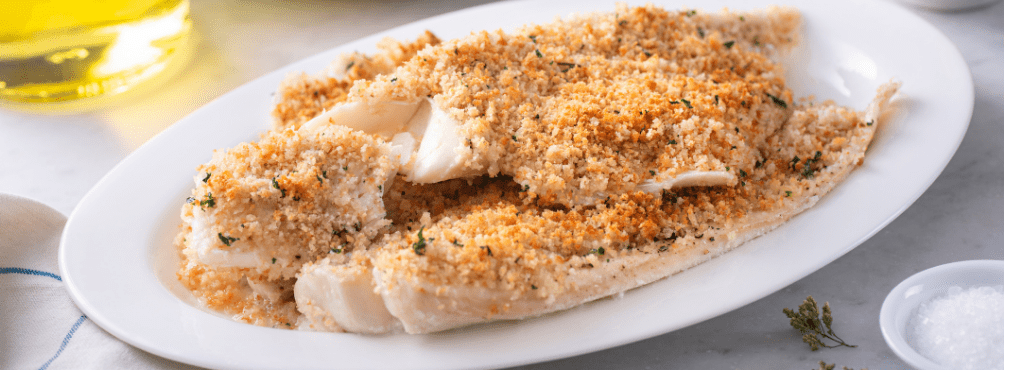
You’ll need:
- A Skillet/Pan
- A cast-iron pan
- Butter
- Paprika
- Panko breadcrumbs
- Cayenne (optional)
- Oregano
- Salt
- Lingcod filet(s)
- Dijon mustard
Instructions:
- Melt some butter into the skillet/pan.
- Add the breadcrumbs, paprika, oregano, and cayenne.
- Toast the mixture and set the pan aside
- Place lingcod into a cast iron pan
- Smear your mustard onto the lingcod.
- Put the breadcrumbs onto the lingcod, using the mustard as adhesive.
- For every inch (2.54 cm) of filet thickness, bake the fish for an additional eight minutes.
- Allow the fish to have an extra minute or two in the oven for a golden-brown finish, and enjoy!
Baked Lingcod with Tomato Caper Sauce
If you want a unique twist on this fish favorite, the tomato caper sauce adds flavor and zest to your lingcod. If you need to whip up your dinner in a hurry, you can even prepare the sauce ahead of time. This dish pairs well with pasta, salad, or veggies to suit Paleo or Gluten-free diets.
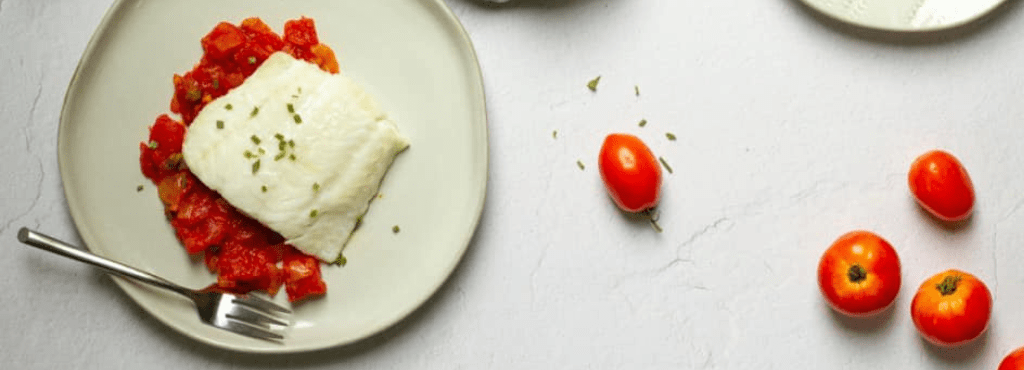
You’ll need:
- A saucepan
- An oven-safe skillet or pan
- Olive oil
- Diced onions
- Diced garlic cloves
- Capers
- Diced fresh tomatoes or canned tomatoes
- Fresh Thyme
- Lemon
- Sea salt
- Lingcod filet(s)
- Pasta, rice, or another optional side dish
Instructions:
- With a little olive oil, cook the diced onions in the saucepan until it is tender, then add the capers and garlic.
- Continue cooking for a minute or two until the garlic is fragrant.
- Next, add the tomatoes, salt, and thyme and simmer over medium heat until the sauce thickens about 10 minutes. Remove from heat, and cover to keep warm.
- Place the lingcod filet(s) in an oiled oven-safe skillet or pan and top with lemon slices.
- Cover with foil and bake in the oven at 450-degrees for 8 minutes for every inch (2.54 cm) of filet thickness. Remove when fish is tender to pierce with a fork.
- Serve immediately with caper sauce and enjoy!
Final Thoughts
Lingcod are fun and challenging to catch.
Now that you’re armed with our tips on how to catch lingcod, stock up on some lingcod lures and you’ll be landing a sizable specimen in no time.
I hope this article has improved your understanding of how to catch lingcod, and I’d love to hear how you get on.

